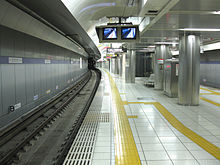Tactile paving
The purpose of the blister surface is to provide a warning to vision-impaired people who would otherwise, in the absence of a change of height of >25 mm, find it difficult to differentiate between where the footway ends and the carriageway begins.
They should never be installed closer to the edge than that, because pedestrians may not have sufficient time to stop walking once they have detected the tactile warning surface.
[5] The purpose of the guidance path surface is to guide vision-impaired people along a route when the traditional cues, such as a property line or kerb edge, are not available.
The profile of the corduroy tactile surface comprises rounded bars running transversely across the direction of pedestrian travel.
[5] The United Kingdom Department for Transport guidance on the installation and use of tactile paving places a heavy emphasis on the role of contrast.
Arguments have been made that the money spent on installing tactile pavement could have been much better spent making other improvements which would benefit vision-impaired people, such as faster repairs to broken pavement,[7] and that more thought should be put into balancing the needs of vision-impaired pedestrians and mobility-impaired pedestrians, such as wheelchair and cane users, who can trip on the bumps.
[9] At stairs, detectable warning surfaces are required (long bars that in the United States are called "directional bars" but are placed at perpendicular to the main path of travel), whereas offset truncated dome detectable warning surfaces are used for ramps, elevated platforms (like those found at the edges of boarding platforms in transit facilities), and at other areas where pedestrian ways blend with vehicular ways.
The federal government, through studies and guidance provided by advocates and the Access Board,[11] now mandates detectable warnings in prescribed locations, such as on the surface of pedestrian curb cuts and at the edges of rail platforms.
[13] Specifications for current enforceable ADA detectable warnings truncated domes regulation for the general public, is the United States Department of Justice 28 CFR part 36 Revised as of July 1, 1994.
[citation needed] Tactile ground surface indicators are installed broadly in major cities such as Beijing, Shanghai, Shenzhen, Dalian and Guangzhou.
[10] In the metropolitan cities of Mumbai and Delhi, warning and directional blocks, resembling those in Japan, have been installed in sidewalks leading to and inside metro stations.
Since 1994, Japanese law require buildings exceeding floor area of 2,000 m2 (22,000 sq ft) to install and maintain tactile pavings near stairs, ramps, escalators and major pathways.
[18] Schools, hospitals, theatres, arenas, community centres, exhibition halls, department stores, hotels, office, multidwelling units, or senior homes with floor space less than 2,000 m2 (22,000 sq ft), must spend reasonable effort to install and maintain tactile pavings inside the building, but it is not required.
[19] Also by law, all transit facilities in Japan must install directional tactile pavers connecting the path from public entrance to the boarding area or staffed booth.
[10] In addition, Pulau Tikus and Brickfields have installed tactile paving to helping vision-impaired people get to surrounding places.
Tactile ground surface indicators are frequently installed across the entire sloped area leading to a crosswalk, creating an obstacle for wheelchair users and others.
Within this framework, work is currently being done on the installation of tactile paving which guides vision-impaired people from when they enter the station until they board a train.
[21] The Australian Human Rights and Equal Opportunity Commission (HREOC) released guidelines on access to buildings and services[22] in 2007, under the Disability Discrimination Act 1992.
In general, tactile indicators in New Zealand are required to: Warning tactile indicators in New Zealand are mandatory at pedestrian cross-walks (also called pram ramps or kerb crossings in New Zealand), at the approaches to stairways, ramps, escalators and moving walkways, the approach to railway level crossings, bus hoarding areas, median cut-throughs, along the entire length of railway platform edges, and before any abrupt changes in grade to the walking surface (1:8 change with a kerb height of more than 70 mm).
Warning tactile indicators in New Zealand need to be installed to the full width of the approach to the obstacle/hazard so as to minimise the risk of a vision-impaired person stepping over or through the pad and encountering the obstacle.
Given the large size, height and slipperiness of the metal disks used in the Belgian blocks, they are likely to present a significant obstacle for wheelchair users, children and the elderly.
Being only 3 mm in height, these protrusions create no obstacle for wheelchair users or elderly pedestrians but also seem likely to go unnoticed by the vision impaired.
Since 2008, Paris has been emphasizing barrier-free accessibility, including such experimental efforts as the uniquely configured blocks installed at the Montparnasse rail station.
[10] Most railway stations and tram or bus stops are fitted with lines of tactile paving, similar in layout to those in Japan.
Inspired by a few, clear design principles (universality of signs, safety, durability), the system allows endless applications in both exterior and interior.
The modular elements that make up the path, with channels specially designed in shape, spacing, height and radius of the relief, and colour contrast, allow the blind and partially-sighted to navigate a route through their and soles, with a white stick, .
[10] Tactile ground surface indicators are installed in accordance with unique standards established by the United Kingdom's Department for Transport.
Pavers with dots or bars are used, and are mainly installed at pedestrian crossings, refuges, at railway station and tram platforms and at the top and bottom of stairs.
Blocks are installed in an L-shaped configuration at crosswalks with push-button traffic signals, with the corner of the L marking the location of the push button.
[25] Railway stations are increasingly fitted with tactile paving, due to the response of a blind person falling off of it and almost being hit by a freight train.












